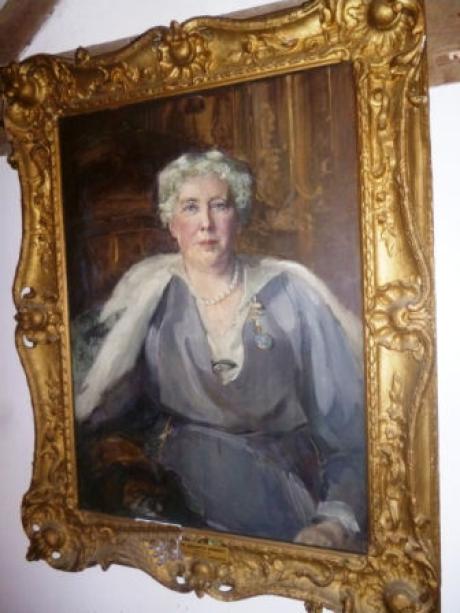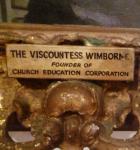indistinctly signed
Lady Cornelia Henrietta Maria Spencer-Churchill, was born on 17th september 1847. She was the daughter of John Winston Spencer-Churchill, 7th Duke of Marlborough and lady Frances Anne Emily Vane. She maried Ivor Bertie Guest, Ist baron Wimborne of Canford Magna, son of Sir Josiah John Guest, 1st Bt and lady Charlotte Elizabeth Bertie. Lady Cornelia was invested as a Officer, order of the British Empire. She was buried on the 26th Jan 1927 at Canford manor, Dorset. Lady Cornelia was a leading evangelicals in the country a great Philanthropist and champion of educationm, being a founder of the Church education corporation. She also set up the serbian relief Fund in 1915.
Sir Ivor Bertie Guest was directly connected with trade. His mother Lady Charlotte Schreiber was the daughter of the Earl of Lindsey but his father Sir John Josiah Guest had been a successful ironmaster. What is more, the Guest family still owned and ran the vast ironworks at Dowlais near Merthyr Tyfill, at one time the largest in the world. It was a sign of the family’s wealth and rising position in society that Sir Ivor could aspire to marry a duke’s daughter.
In 1846, Sir John Josiah and Lady Charlotte had bought the Canford manor estate near Poole for £335,000, remodelling the house at considerable expense as a fitting family home. When Sir John Josiah died in 1852, Ivor, the eldest son, was only seventeen and it was the formidable Lady Charlotte who took over the direction of the ironworks, the management of the estate and the care of her ten children, the youngest being only five years old. In 1855, at the age of 42, she caused a minor scandal by marrying her son’s tutor, Charles Schreiber, who was fourteen years her junior. After Ivor’s coming of age, celebrated with a lavish party at Canford, he took over the management of the business and the estates but his life style was still more that of a wealthy gentleman than of an ironmaster. Besides the properties in Wales and Dorset, he also owned the 65,000 acre Achnashellach Lodge estate in Ross-shire described as the finest deer forest in Scotland. The year before his marriage he bought No. 22 Arlington Street, St. James’s, London, the former home of two prime ministers and several dukes and earls. This he renamed Wimborne House and renovated with the addition of a splendid ball room with elaborate gilded mouldings.
At Canford Manor they entertained leading members of society, politicians, aristocrats and royalty in a round of house parties, shooting parties, political fetes and horticultural shows. The house was equipped with every convenience and luxury including a billiard room and a real tennis court. There was also a philanthropic side to their lives. Like many Victorians, Lady Cornelia believed in charitable social improvement and continued projects started by her mother-in-law besides initiating many of her own. Lady Charlotte had decided to improve the living conditions of Canford tenants by building a number of cottages in a rustic gothic design to the very latest standards. Around 111 of these ‘Lady Wimborne cottages’ were eventually built, mainly during Lady Cornelia’s regime, and many of them can still be seen today all over the former estate.
From 1874, Sir Ivor tried unsuccessfully for election as a Conservative in Glamorgan, Poole and then Bristol, eventually leaving the Conservative group and entering the House of Lords as a Liberal. In 1880, he was created a baron by Disraeli. Given her husband’s political preoccupations, it was probably Lady Cornelia who was most active in local schemes. Following the Education Act of 1870, which required the provision of primary education for all, the Guests sponsored the building of schools at Hampreston, Hamworthy and Broadstone in the same distinctive gothic style as the cottages. They also gave generously towards the founding of churches in Parkstone and Broadstone and played a big part in the development of the estate by offering land for sale at low prices. Speculation was discouraged by the estate retaining first refusal on any houses offered for sale.
Another important development for Poole was Lord and Lady Wimborne’s donation of 26 acres of land on the shores of Parkstone Bay for the creation of Poole Park. As the Prince of Wales was to visit Canford in January 1890, Lord Wimborne suggested that his royal guest would be willing to formally open the park. In the event, the visit was slightly marred by absence of the Princess of Wales and her daughters who were suffering from severe colds. Lord Wimborne was also afflicted and had to take to his bed. At Canford, every luxury was laid on and a congenial house party provided for the prince. Unfortunately, the actual opening did not go according to plan because a storm of wind and rain wrecked the decorations in the park. The ceremony was successfully performed in the station booking office before the prince set off on his journey home!
The mayor that year was the outspoken solicitor, Philip Budge who once said of Lady Cornelia that ‘she had an irresistible means of getting her own way which should cause any man that did not agree with her to fly to the uttermost ends of the earth’. She also was a great public speaker, said to never speak at less than 150 words a minute; in fact she was a pocket whirlwind hard to deflect when she was pursuing one of her charitable projects.The same year as the opening of the park, Lady Cornelia persuaded her husband to buy the old mansion house of Sir Peter Thompson in Market Street, Poole. Here she set up a 30 bed hospital to replace the small surgery she had started in West Street. Cornelia Hospital as it became known, served the community for many years before it was transferred to a purpose-built premises in Longfleet Road on land donated by Lord Wimborne. It was also Lord and Lady Wimborne who laid out the golf courses at Broadstone and Parkstone, in the first instance for the use of their family and friends, but later opening them to others.
The death of Lord Wimborne in 1914, marked the end of a period of unprecedented philanthropy at Canford. Lady Cornelia stayed on at the manor until 1922 when she moved into Merley House and then the unprofitable parts of the estate were sold, including the manor house which became a school. Lady Cornelia died in 1927 in London at the age of 79. In her obituary she was described as ‘one of the most influencial of late Victorian hostesses’. ‘Her Ladyship was possessed of great force of character. Had she been of the opposite sex or had she been born 20 years later, she would probably have figured as prominently in politics as her brother, Lord Randolph Churchill, or her nephew, Mr. Winston Churchill.’ Locally she is remembered for a great number of charitable projects which had a lasting impact on the town of Poole and as a representative of almost unimaginable wealth and privilege from an era now vanished.
with thanks to Jenny Oliver


